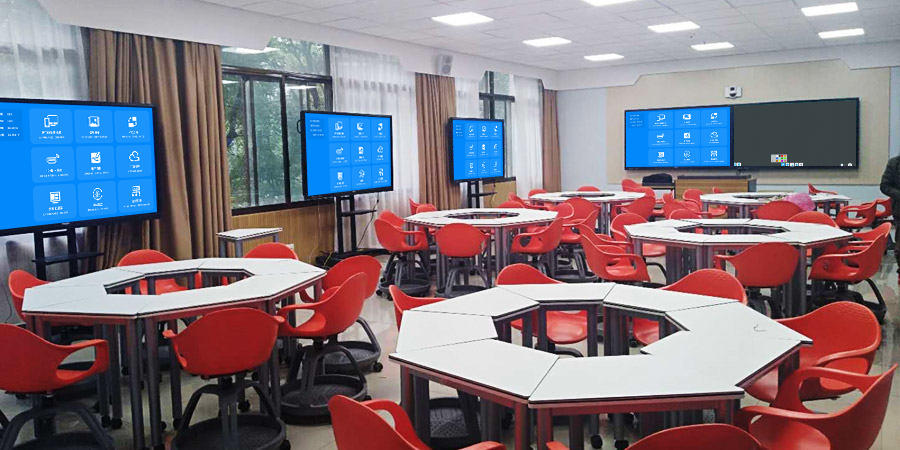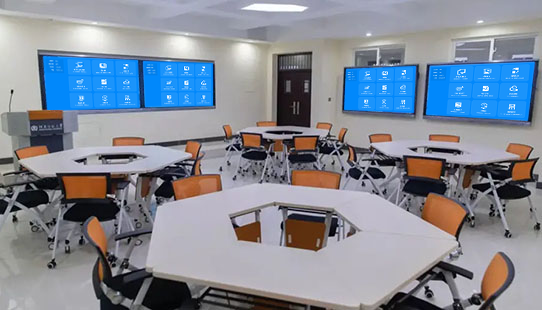Group Discussion: An Efficient Collaboration Solution for Team Members
The Group Discussion solution addresses pain points in team collaboration such as “information not being synchronized, difficulty in consolidating ideas, and difficulty in tracing outcomes.” It uses a technical architecture of “device interconnection + functional linkage + data consolidation” to provide full-process support for group discussions in scenarios like corporate meetings, classroom teaching, and project R&D. This allows team members to move from fragmented communication to deep collaboration.
Core Device Architecture
- Group Interactive Terminal: Each group is equipped with a 21.5-inch touch screen + a wireless mirroring module. It supports one-click mirroring from all devices (phones, tablets, and computers), with a 4K quality transmission latency of ≤30ms, ensuring that details like sketches and data tables are clearly presented.
- Main Venue Control Center: An 86-inch 4K main screen is deployed. It is interconnected with each group’s terminal via a distributed system, allowing it to view all group discussions and shared content in real time. It supports display modes such as single-group magnification and multi-group comparison.
- Mobile Collaboration Tools: Paired with a Bijie smart stylus and a wireless microphone, group members can write annotations and make voice notes on the interactive screen. The handwriting and audio are recorded simultaneously, making the collaboration trail fully traceable.
Key Collaboration Features
- Real-Time Content Sharing: Documents, pictures, and videos within a group can be pushed to the group’s interactive screen with one click. Members can directly annotate and edit using the touch screen, and the changes are synchronized in real time to all members’ terminals. For example, during a marketing group’s discussion of a proposal, a member can mirror a competitor analysis from their phone, and others can annotate key data on the interactive screen, making the exchange of ideas more intuitive.
- Cross-Group Information Linkage: The main venue can push reference materials to a designated group, and a group can also “push” its discussion results to the main screen for display. It supports a split-screen comparison of content from up to 8 groups simultaneously. For example, different proposals for an R&D project can be presented side-by-side on the main screen. The representatives from each group can explain their design ideas using the interactive screen, increasing cross-referencing efficiency by 50%.
- Collaboration Process Recording: The system automatically records group discussion videos, simultaneously marking key points like mirrored content, handwritten annotations, and voice speeches, and generates a collaborative archive with a timeline. After the meeting, the discussion video and annotated files can be exported with one click, avoiding the “forgotten after the meeting” syndrome and improving the efficiency of outcome consolidation by 60%.

Scenario-Based Application Solutions
(I) Enterprise Meeting Group Discussions
- Strategic Planning Meeting: The meeting is divided into 5 groups based on business lines. Each group’s interactive screen displays the company’s annual data, and members use a stylus to annotate growth points and risk points. The main screen captures the most frequent keywords from each group’s annotations, forming a word cloud of “market expansion,” “cost control,” etc., which assists in the final decision-making and improves meeting output efficiency by 40%.
- Product Brainstorming Meeting: A design group mirrors a prototype sketch onto the interactive screen, and members use different colors to annotate revision suggestions. The system automatically tallies the most frequently requested features. The main venue summarizes the popular suggestions from each group and generates a product requirements list, shortening the solution iteration cycle by 30%.
(II) Classroom Group Teaching
- Group Project Research: 6 student groups conduct a discussion on an “environmental solution.” Each group uses a tablet to film their research and mirrors it to the interactive screen. Members divide the work of annotating data and case studies. The teacher monitors the progress of each group via the main screen and pushes reference documents to groups that are stuck. Finally, the results from each group are displayed in a split-screen view on the main screen, and students use a stylus to explain their logical framework, increasing class participation by 70%.
- Collaborative Experimental Analysis: In a science lab, a group mirrors experimental data in real time to the interactive screen and uses the system’s built-in chart tools to generate a trend graph. Members annotate the possible reasons for anomalous data. The teacher calls up the data from 3 groups to compare on the main screen, guiding students to discover the patterns of variable effects, and improving the efficiency of scientific inquiry skills cultivation by 50%.
(III) Project R&D Collaboration
- Cross-Departmental Project: R&D, production, and marketing groups hold a discussion on the launch of a new product. The R&D group displays technical parameters on the interactive screen, the production group annotates production difficulties, and the marketing group adds user needs. The main screen integrates the key information from all three groups in real time, generating a “technology – production – marketing” correlation map, increasing cross-departmental coordination efficiency by 60%.
- Remote Collaborative Discussion: Off-site teams join a group discussion via the Bijie Cloud Platform. The remote members’ video feeds and the local group’s interactive screen content are displayed in a split-screen view. They can use the electronic whiteboard tool to annotate their ideas in real time. The collaboration experience is comparable to being on-site, increasing the speed of cross-regional project advancement by 40%.
Management and Assurance System
- Granular Permission Control: The administrator can set permissions for scenarios like “group mode” and “reporting mode.” During group discussions, members can only operate their own group’s devices. During the reporting phase, the permission to push to the main screen is automatically granted, preventing irrelevant operations from causing distractions.
- Data Security Encryption: Collaboration content transmission uses AES-256 encryption. It has a dual backup (local and cloud) and supports precise historical record retrieval by group and by time, meeting the needs for corporate data compliance and the preservation of teaching archives.
- Simple Deployment and Maintenance: Group terminals support PoE power supply and wireless networking. Deployment time is shortened to 30 minutes per group. The Bijie management platform can remotely monitor device status, automatically prompting for maintenance needs like touch screen calibration and microphone noise reduction. The annual fault rate is controlled within 2%.
The core value of the Group Discussion solution is to transform “fragmented discussions” into “structured collaboration.” It uses device interconnection to break down spatial limitations, functional linkage to activate member participation, and data consolidation to solidify discussion outcomes. This ensures that every group discussion can produce clear conclusions and every collaborative step can be advanced efficiently, redefining the standard of team collaboration efficiency.